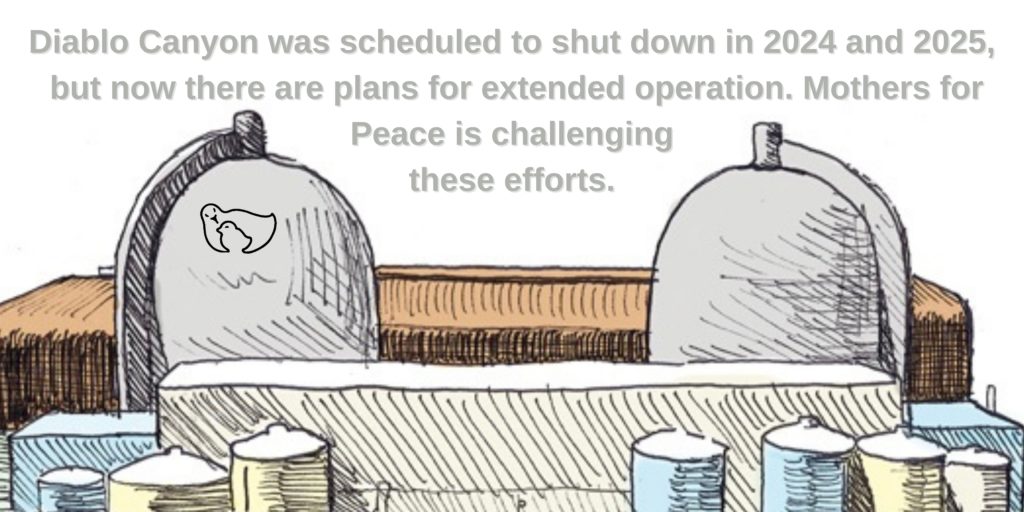
Diablo Canyon nuclear plant was scheduled to retire in 2024 and 2025 through a 2016 joint agreement between its owner, Pacific Gas and Electric Company (PG&E), labor, consumer advocacy and environmental groups. However, over the last year, there has been a push to extend operations beyond these shutdown dates based on Governor Newsom’s claim that its energy is needed.
Senate Bill 846 was passed by the California legislature which has enabled the extended operation. State and federal subsidies have been granted to PG&E to support this effort. PG&E has applied to the Nuclear Regulatory Commission (NRC) for a 20-year extension of Diablo Canyon’s operating license, although SB 846 asks for only five years.
The NRC has disregarded its own rules by approving continued operation of the Diablo Canyon reactors past their expiration dates without the required environmental reviews and opportunity for a hearing. The NRC only stipulates that the PG&E must submit a license renewal application by the end of 2023 (which it has submitted), but may operate the reactors indefinitely until such time as the NRC makes a decision on the application.
San Luis Obispo Mothers for Peace is working hard to show regulators and the public why an extension of Diablo’s licenses is exactly the wrong thing to do when California needs to accelerate movement toward a safe, reliable, all-renewable energy portfolio.
Mothers for Peace and numerous environmental groups and energy experts agree that continued power generation at Diablo is not needed in the projected timeframe. Furthermore, the plant’s continued operation obstructs the development of other, actual, renewable sources by taking distribution space on the energy grid.
There are numerous safety risks at this aging plant:
Earthquake Danger
Two of the 13 identified nearby faults are considered by the U.S. Geological Survey to be “active” and “major”.
Embrittlement Danger
There is grave concern that the reactor vessel of Unit 1 is compromised and is at risk of thermal shock. An embrittled reactor vessel can shatter like glass and cause a catastrophic meltdown. Despite awareness of this, PG&E has not tested for embrittlement for over 20 years – and the NRC has approved the exemptions. The next plan is to test in 2025 with results available in 2026.
Onsite Storage of High Level Radioactive Waste
There is the intractable problem of safe, secure, and just storage of the six million pounds of radioactive nuclear waste at the site in an active seismic region – with plans to generate even more.
Delayed Maintenance and Capital Projects
Since 2016, PG&E has been planning for closure. Its systems and components are old, and PG&E has put off projects due to the expected closure.
Mothers for Peace Legal Challenges
Mothers for Peace is challenging extended operation through various channels.
NUCLEAR REGULATORY COMMISSION: The NRC exempted PG&E from its “Timely Renewal Rule” and approved continued operation of the Diablo Canyon reactors past their expiration dates without the required environmental reviews or opportunity for public hearings. PG&E may operate the reactors indefinitely until such time as the NRC makes a decision on the license renewal application.
In partnership with Friends of the Earth and Environmental Working Group, we petitioned the NRC to deny PG&E’s license extension on the basis of its violation of the “timely renewal” clause in its own regulations. The NRC denied our petition, and we have filed an appeal in the 9th Circuit Court. Diane Curran represents us before the Nuclear Regulatory Commission.
CALIFORNIA PUBLIC UTILITIES COMMISSION: Mothers for Peace is also engaged in the California Public Utilities Commission (CPUC) proceeding. We have hired experts on seismicity, materials engineering, and renewable energy to address the fundamental issue on why it is not in any way prudent to extend Diablo Canyon’s operating licenses. In our filings, we have challenged both the need for Diablo’s power and the outrageous costs of refurbishing the nuclear plant and all of its parts to meet safety standards necessary to protect our nearby communities. In December of 2023, the CPUC approved extended operation without all the information required by SB 846 – and despite evidence that Diablo’s energy is not needed to avoid summer blackouts. Sabrina Venskus represents us before the California Public Utilities Commission.
CALIFORNIA COASTAL COMMISSION: The CCC holds proceedings regarding PG&E’s proposed Consistency Certification and Coastal Development Permit application. The Environmental Defense Center is managing ocean issues involving the proposed extension of Diablo Canyon’s licenses.
Regardless of the outcome, Diablo Canyon will eventually be decommissioned. The process is expected to take approximately ten years.
A multitude of issues surround the decommissioning process:
• destruction of plant structures
• removal / transportation of the demolished materials
• onsite, long term storage of high level radioactive waste
• repurposing of the facilities (buildings, desalination plant, harbor, breakwater…)
• future use of the Diablo Canyon lands
• economic impacts of closure
The SLO County Board of Supervisors has been given the responsibility to oversee the decommissioning of the plant.

PG&E created the DCDEP in 2018 to promote dialogue with the community on matters related to decommissioning. Panelists are community members from across San Luis Obispo County who represent diverse viewpoints. Mothers for Peace Spokesperson Linda Seeley is a member of this Panel. This allows our voice to be heard regarding issues of great importance to us.
The Panel has written a document titled “Strategic Vision, Goals and Recommendations”. This document is regularly revised, updated and refined as the Panel continues to hold public meetings and workshops and takes community comments on issues associated with the decommissioning process.
The Strategic Vision was submitted to the California Public Utilities Commission as part of the Nuclear Decommissioning Cost Triennial Proceeding. You can read the report here. Mothers for Peace supports nearly all of its recommendations.
The panel has its own website which provides meeting information and an opportunity to submit public comments.
